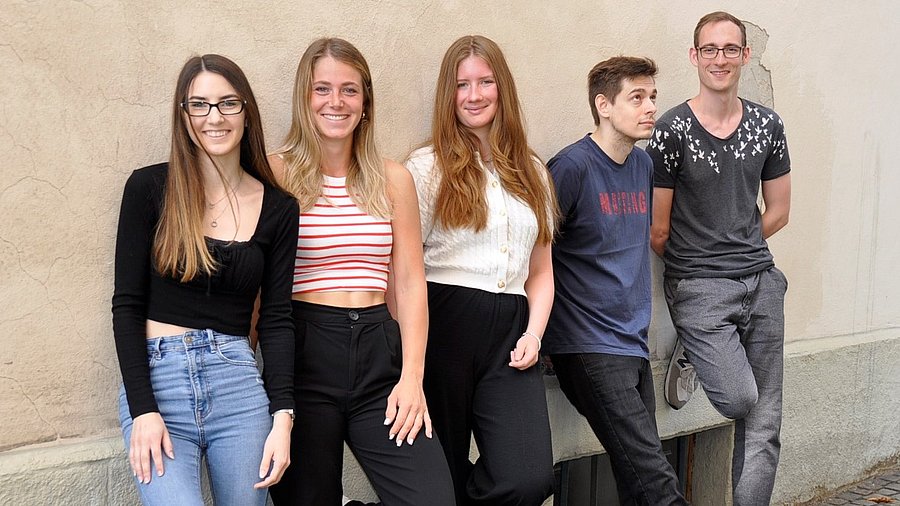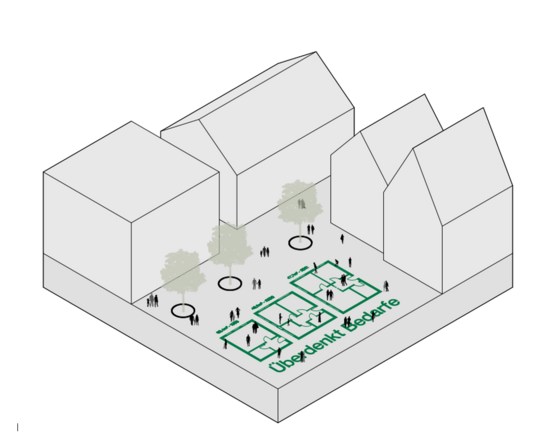
Ideas for a sustainable building revolution
From left to right: Saskia Bachmann, Hanna Stallmann, Lena Königbauer, Dimitry Feller, Valentin Riede - not in the picture Christopher Schulz) / Architecture
Photo: UniService Transfer
A building culture to be redefined
Architecture students develop convincing ideas for implementing a sustainable building revolution
Architects 4 Future, an association of architects, engineers, craftspeople and developers, are campaigning for sustainable change in the construction industry because they say that the construction sector and the operation of buildings in Germany and other countries cause around 40% of greenhouse gas emissions and 55% of waste. Large-scale sealing for new settlements takes up an area of around 80 football pitches in Germany alone, destroying ecosystems and increasing heat effects and flood risks. In February 2023, they called for a holistic turnaround in construction and a redefined building culture in a 10-point plan.
A social rethinking process
Climate change is not a temporary phenomenon that can be cancelled at any time, says Annette Hillebrandt, professor of architecture at the University of Wuppertal. It is about making the challenge of the building revolution visible to the public and encouraging people to get involved and sit down with the experts at a table to to find solutions to . At their Chair of Building Construction/Design and Materials Science at the Bergische University , now students have taken a close look at the demands of Architects 4 Future and asked themselves what methods and ideas can be used to bring this rethinking process into society. Among other things, this resulted in five strong proposals that can inspire professionals to reflect.
Sustainable and healthy building practices for all
Saskia Bachmann and Hanna Stallmann are developing an app called "Baufuture" that is accessible to everyone. Instead of laboriously trawling through countless websites, users will find compact and comprehensible information on this app based on the requirements of Architects for Future. "We want to pool all the knowledge and make it accessible to everyone, including architects and planners as well as building owners and interested members of the public," says Bachmann. "The app is designed to be interactive, there are quiz questions for each requirement to test your knowledge and you can also find an example for each one." Various approaches are used to provide the best possible recommendations for action. For example, materials for circular and climate-positive construction are listed and explained, drawing on the existing database of the Materials Library of German Universities. Users can use self-created checklists to find out how healthy building works. Research approaches for strengthening climate resilience are explained in a practical way using existing examples, and this app can be continuously expanded with new information.
Recycling station on site
Student Dimitry Feller has been thinking about the many working models and prototypes produced by architecture students using 3D printing, most of which end up as waste. "I noticed the problem at our university. We produce a lot of 3D prints because we attach great importance to developing a formal language and expressing the whole thing in a three-dimensional way." Students sometimes bring in up to 10 models a week and Feller came up with the idea of recycling the plastic exhibits at the university that were no longer needed. "If we collect this plastic from the 3D prints, shred it and melt it down again, we can use it to produce new filament for reuse." An on-site recycling station also raises awareness of the sustainable use of plastic.
Beat the heat
Christopher Schultz has been dealing with the increasing number of heatwaves caused by climate change. "Strong and long periods of heat will form localised heat islands more frequently and regularly in urban areas. A high degree of sealed surfaces and too few green spaces exacerbate this development. Vulnerable groups of people, such as children and the elderly, will be particularly at risk. The aim must be to improve the urban microclimate through low-threshold and low-tech interventions with little bureaucracy, efficiently and quickly," he explains. Knowing that German cities are rarely liquid, Schultz comes up with low-cost, quick-to-implement best-practice ideas that show how to improve the microclimate, increase quality of life, strengthen climate resilience and activate open spaces through many small measures. "These are examples that can be implemented relatively quickly without having to rely on the city or investors," he explains. "It's about pavilions, i.e. showrooms, that can be set up in cities and that use green façades in large sealed squares , for example, to show that shading can be added without major structural effort . This extends the length of stay. This is then coupled with information material that shows that I can also implement these ideas in my own neighbourhood. So you can become an expert yourself and do something independently."

Rethinking requirements: per capita housing floor plans in the past and today
Design by Valentin Riede
Installations in the city centre
Information boards have long since ceased to be enough to draw people's attention to any topic on the street. "That no longer attracts anyone," says Valentin Riede, who can rather imagine installations that he describes as "attractors". Cubes of different sizes could be set up in urban squares, for example. "These cubes represent concrete, brickwork, sand-lime brickwork, rammed earth and (spruce) wood. The surfaces should be made of the same materials, but the supporting structure is made of wood. The sizes of the cubes refer to the number of CO2 emissions of the building materials." The differences in the size of the cubes make it clear to the viewer which materials are the most sustainable. In another example, Riede uses painted floor plans to illustrate living conditions yesterday and today. "These floor plans are intended to draw the viewer's attention to the ever-increasing consumption of living space (per capita)," he says. The installations are intended to make abstract developments understandable and tangible in order to promote a dialogue between citizens and activists.
Becoming an energy consultant
However, all the measures that can be applied in the course of sustainable building are only effective if you have sufficient knowledge of the overall situation. "Since the GEG 2020 (Building Energy Act) came into force, the state's interest in a wide range of energy-efficient individual and overall measures for residential and non-residential buildings has been formalised and a framework for implementation aids has been created. An initial, superficial and therefore free energy consultation is even mandatory for extensive conversions or the purchase of detached or semi-detached houses. Nevertheless, it makes sense to take advantage of more extensive support," says student Lena Königbauer and proposes the implementation of an energy consultant's certificate in the degree programme. "The architect has always acted as a link between the interests of the owners/investors, the legal and physical framework conditions and the implementation on site," she explains. "An architect should have basic knowledge of various trades, which is why I consider this professional group to be a qualified contact person with an extensive range of options in the overall structure." Early training as an energy consultant is attractive for young people, as it opens up a wide range of opportunities, for example to lay the foundations for early self-employment independent of studies. In addition, the knowledge and experience gained at a young age is expanded and grounded in reality. "In many cases, the architect is the first point of contact when it comes to planning and costs, and this is precisely where the current training gap could be closed." Investors could thus be convinced of the idea of sustainable construction by comprehensively trained specialists.
These five different Wuppertal projects show how one could at least start to push the building revolution. Further projects will certainly have to follow in order to anchor sustainable ideas in our society.
Uwe Blass
Students Saskia Bachmann, Hanna Stallmann, Lena Königbauer, Dimitry Feller, Christopher Schulz and Valentin Riede developed project ideas for the Architects 4 Future catalogue of demands under the supervision of Prof. Dipl.-Ing. Annette Hillebrandt from the Chair of Building Construction/Design and Materials Science.
